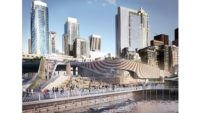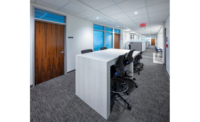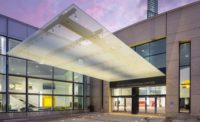LMN Architects celebrated the completion of the new Hines Seattle Headquarters at the Norton Building in downtown Seattle. The project sets a new precedent in low-carbon design in the United States and reflects the firm’s commitment to research and sustainability.
The new Hines Seattle Headquarters on the eighth floor of Seattle’s historic Norton Building provides a thoughtful new paradigm in low carbon and circular design. Intending to eliminate embodied carbon impact without relying on carbon offsets, the design team implemented circular design principles aimed at minimizing waste and the associated wasted carbon. This goal was achieved through the creative reuse of building materials and a meticulous carbon analysis. From an ingenious feature wall composed entirely of wood offcuts to a glazed entry constructed of glass salvaged on-site, the carbon reduction goals informed every decision around materiality. Designing to retain, reuse and source salvaged materials resulted in a measured 65 percent embodied carbon reduction compared to a typical remodel that begins with an empty shell. If the same design did not consider salvage and reuse, and solely relied on specifying low-carbon options, it would only result in a 22 percent reduction.
“The Hines Seattle Headquarters is the next step after our recent and extensive research on the embodied carbon impact of cyclical interior renovations,” commented Jennifer Chen, Principal at LMN Architects. “Knowing the significance of our impact led us to examine and reconsider how we practice and what we can do to further mitigate the amount of carbon the building industry generates. The collaboration with Hines and Sellen Construction towards this common goal has been extremely rewarding, and we are proud of what we have accomplished together with our team.”
The team’s determination to find and repurpose materials that would otherwise end up in the landfill brought new ways to collaborate with local fabricators and vendors, contractors and the client. The standout reception area feature wall consists of reclaimed wood offcuts sourced from local manufacturers that would otherwise have been incinerated. The conference room’s custom tabletop is made with salvaged wood from a fallen tree in the Madrona neighborhood of Seattle. In addition to the overarching carbon reduction goals, it was also important to balance functional and aesthetic considerations to elevate the tenant experience. Still functional materials, such as the existing carpet tiles, were preserved to avoid demolition and landfilling. Its neutral color and pattern became the palette’s foundation, while new accents of shades of blue complemented Hines’ iconic brand red, which is expressed at key moments throughout the space through regionally sourced light fixtures. Where possible, existing partitions were preserved and integrated into the overall space planning after alignment exercises with the client’s programmatic needs. Every existing material was cataloged and tracked to maximize reuse, on-site or elsewhere.
The impact of the sustainable goals of the firm extended beyond the client. Thanks to effort from the team, insulation from demolished partitions was given to aid local rebuilding efforts for the homes of recent flood victims. A finishing design touch features artwork from ArtLifting, a platform for artists that have traditionally been underrepresented in the contemporary art market.
“Our new Seattle headquarters embodies our vision of innovation, sustainability and flexibility,” said Ty Bennion, Senior Managing Director at Hines. “We are fortunate for our partnership with LMN in creating a welcoming and reimagined workspace for our employees.”
The resulting design introduces clean lines and elegant finishes to the workplace, elevating the layout into a fresh, international-inspired office space complete with conference rooms, breakout spaces, a modernly appointed kitchenette and a large communal work area. The focus on reuse resulted in fewer new materials needed, drastically reducing emissions from raw material extraction and manufacturing.
“Working in close collaboration with our client, we set out to design an ambitious low-carbon interior renovation project,” commented Pamela Trevithick, Partner at LMN Architects. “The Hines Seattle Headquarters meet modern sustainability standards and inspire us to be more ambitious with how we think about embodied carbon, our community and the environment. Our clients gave us this valuable opportunity to implement some of the concepts developed by our team of sustainability experts, and we look forward to continuing developing our research on embodied carbon and scaling this commitment on more of our projects.”
With the Hines Seattle Headquarters, LMN Architects is raising the bar in carbon-conscious design by successfully committing to low carbon in every form and providing support for the local community. Thanks to a strong partnership with Hines and shared sustainability goals, LMN has created a new standard of low-carbon design.
Hines is a global real estate investment, development and property manager. The firm operates in 28 countries and manages a $92.3 billion portfolio of high-performing assets across residential, logistics, retail, office and mixed-use strategies.









